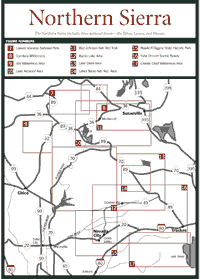 Northern
Sierra
Northern
Sierra  Northern
Sierra
Northern
Sierra Volcanic activity of the last 50,000 years in the Northern Sierra created the basalt and andesite ridgelines and features that spread across the northern part of the batholith anchoring this mountain range. The farther north the visitor travels, the lower the peak elevations, as the batholith submerges beneath the earth's surface. Mountaintops can still reach higher than 9,000 feet in the Northern Sierra, but people do not come to this part of the mountain range for a high country experience. They come for the fishing, the sight-seeing, the rivers, and the camping.
While the porous volcanic surfaces allow water to seep into the ground much easier than granite, thus preventing the formation of many lakes, places such as the Plumas National Forest have become known as meccas for trout fishing. The lakes on the Plumas are formed by hydroelectric projects and are well-stocked with trout and other freshwater fish.
The Northern Sierra is also known for weather. The precipitation gauge runs a bit deeper here; the forests appear greener, the temperatures cooler. The Feather River, for instance, can carry as much water as several Southern Sierra rivers combined because there is simply more rain and snow in the Northern Sierra.
The increased precipitation is part of the regional weather flow in the western United States. Storms coming in from the Pacific Ocean generally drop a lot of their moisture in the Northern Sierra and begin to taper off as they encounter atmospheric high pressure areas in the central and southern portions of the mountain range.
This weather pattern promotes forests that are greener in the Northern Sierra than in the more arid Southern Sierra. The green forests, rich in nutrients and insect life, make a wonderful habitat for diverse wildlife, particularly birds.
Geologists say the Northern Sierra ends roughly around Lake Almanor in the Lassen National Forest, where the batholith subtly disappears beneath the younger rocks of the Cascades. Indeed, the Sierra proper does not include Lassen Volcanic National Park, the spectacular show of volcanism in the Cascade Range just a few miles from Almanor. But the volcanic southern edge of the Cascades is so close that visitors to the Northern Sierra will also want to view the park.
The three forests of the Northern Sierra—the Tahoe, Plumas, and Lassen—do not include Lake Tahoe for the same reason that the lake is not lumped in with the Northern Sierra in this book. Lake Tahoe, much like Yosemite National Park, is literally in a class by itself as an outdoor destination and a natural location. The U.S. Forest Service considers the lake to be a separate entity, supervising it with the Lake Tahoe Basin Management Unit.
Even without Lake Tahoe, the three northern forests have quite a recent history of their own. Gold mining, grazing, logging, railroad building, hydroelectric project construction, and logging fill the area with remnants and scars that define the mountain and foothill communities. As a distinct area of the Sierra, these forests have characteristics not found anywhere else in the range.
Read and add comments about this page